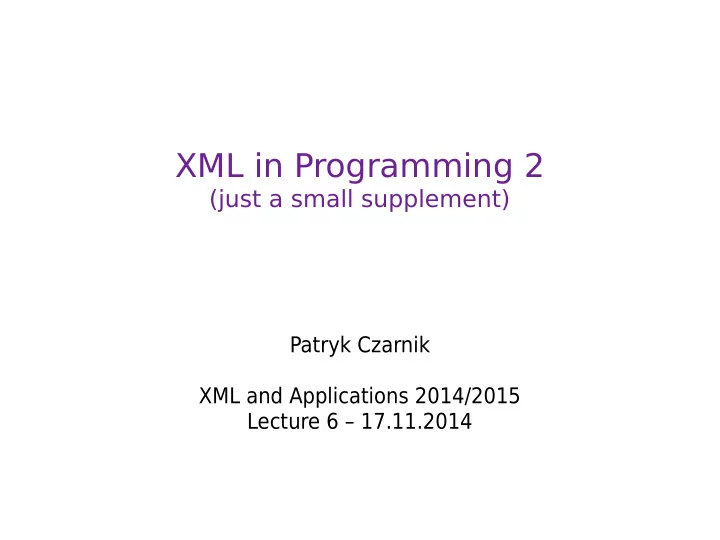

XML in Programming 2 (just a small supplement) Patryk Czarnik XML and Applications 2014/2015 Lecture 6 – 17.11.2014
Features of JAXP 3 models of XML documents in Java: DOM, SAX, StAX Formally JAXB is a separate specifjcation Reading and writing documents Transformations of XML documents (Transformers) applying XSLT in our programs translating internal form of representation XPath support Validation against DTD (only during parsing) against XML Schema (during parsing or using Validators) against XML Schema 1.1, Relax NG, or other alternative standards – when implementation supports 2 / 8
T ransformer: source and result T ransformer Source Result StreamSource StreamResult DOMSource DOMResult JAXBSource JAXBResult SAXSource SAXResult StAXSource StAXResult SAAJResult 3 / 8
Applications of Transformers Simple: invoking XSLT transformations from Java changing internal representation of XML in our program Tricky: parsing and writing documents, e.g. serialisation of a DOM tree serialisation of modifjed (or generated) sequences of SAX events (together with SAX fjlters) enabling “on-the-fmy” processing of large XML documents 4 / 8
Editing XML documents More natural when whole document present in memory DOM – generic API JAXB – deep embedding of XML in application model Harder, but possible, using node-by-node processing required when processing big documents while having little memory suggested for big (“long and fmat”) documents and simple local operations – then we can save substantial resources StAX – possible using “writers” IMO XMLEventWriter more convenient than XMLStreamWriter SAX no direct support for editing/writing available indirect solution: SAX fjlters and Transformer 5 / 8
Validation Against DTD setValidating(true) before parsing Against XML Schema (or other schema formats, if implementation supports) setSchema(schema) before parsing using Validator Validator API validate(Source) – only checking of correctness validate(Source, Result) – augmented document returned not possible to use as T ransformer – source and result must be of the same kind (my private observation) – not always working as expected 6 / 8
Handling errors Most JAXP components (specifjcally SAX and DOM parsers, Validators) may throw SAXException signal errors through ErrorHandler events Interface ErrorHandler 3 methods (and severity levels): warning, error, fatalError registering with setErrorHandler allows to override default error handling Required to manually handle validation errors 7 / 8
XPath support in Java DOM XPath module implementation org.w3c.dom.xpath offjcially not a part of Java SE, but available in practice (by inclusion of Xerces in Oracle Java SE runtime) JAXP XPath API javax.xml.xpath most effjcient when applied for documents in memory (DOM trees) our examples show this solution Note: using XPath may signifjcantly reduce developer's work, but the application may be less effjcient (than if we used SAX, for example) 8 / 8
Recommend
More recommend